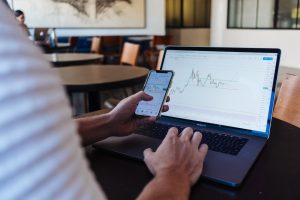Leverage in forex trading is a tool that allows traders to increase their exposure to the markets without having to commit a large amount of capital. It is a double-edged sword, however, as it can increase both potential profits and losses.
Leverage is essentially borrowing money from a broker to trade. For example, if a trader has $1,000 in their account and a leverage ratio of 100:1, they can effectively trade with $100,000. This is because the broker is lending the trader the remaining $99,000.
The most commonly used leverage ratios in forex trading are 50:1, 100:1, 200:1, and 400:1. The higher the leverage ratio, the greater the potential profit or loss.
Leverage is a powerful tool for forex traders, but it is important to use it wisely. Traders should always consider their risk tolerance and never risk more than they can afford to lose.
Advantages of Leverage in Forex Trading
One of the major advantages of leverage in forex trading is that it allows traders to control larger positions with smaller amounts of capital. This means that traders can potentially earn greater profits from their trades without having to commit a large amount of money.
Another advantage of leverage is that it can provide traders with greater flexibility in their trading strategies. With leverage, traders can take advantage of small price movements in the markets and generate profits quickly.
Leverage also allows traders to diversify their portfolio and trade a variety of currency pairs. This can help to spread the risk and reduce the potential impact of any single trade.
Disadvantages of Leverage in Forex Trading
While leverage is a powerful tool for forex traders, it also comes with a number of risks. One of the biggest risks is that it can amplify losses as well as profits.
If a trader is not careful, they can easily lose more than their initial investment. This is because leverage magnifies both the potential gains and losses. Traders must always be aware of the risks involved and use appropriate risk management techniques.
Another disadvantage of leverage is that it can lead to overtrading. When traders have access to large amounts of capital, they may be tempted to take on too many trades at once. This can be dangerous as it increases the risk of losses and can lead to emotional trading decisions.
Leverage can also increase the cost of trading. Brokers typically charge higher fees for leveraged trades, which can eat into profits.
How to Manage Leverage in Forex Trading
To manage leverage in forex trading, traders should always start by setting a clear risk management strategy. This should include setting stop-loss orders to limit potential losses and taking profits at predetermined levels.
Traders should also be aware of their risk tolerance and never risk more than they can afford to lose. This means setting a maximum percentage of their account balance that they are willing to risk on each trade.
Another important factor to consider when managing leverage is to stick to a trading plan. This means avoiding emotional trading decisions and sticking to the strategy that has been developed.
Conclusion
Leverage is a powerful tool for forex traders, but it comes with a number of risks. Traders must be aware of the potential for both profits and losses and use appropriate risk management techniques.
By setting clear risk management strategies, being aware of their risk tolerance, and sticking to a trading plan, traders can successfully manage leverage in forex trading and potentially generate greater profits.





